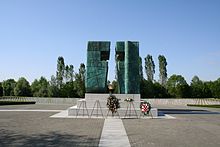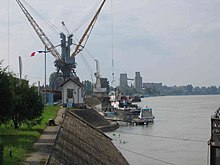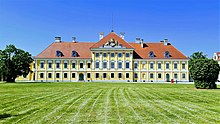Vukovar
|
Vukovar Вуковар |
|||
|
|||
|
|
|||
| Basic data | |||
|---|---|---|---|
| State : |
|
||
| County : |
|
||
| Height : | 108 m. i. J. | ||
| Residents : | 27,683 (2011) | ||
| Telephone code : | (+385) 032 | ||
| Postal code : | 32,000 | ||
| License plate : | VU | ||
| Structure and administration (status: 2014) |
|||
| Community type : | city | ||
| Mayor : | Ivan Penava ( HDZ ) | ||
| Coalition partner : | HSP AS, HSS, HČSP, DC, BUZ | ||
| Website : | |||
Vukovar [ ˈʋukɔʋaːr ] ( Serbian - Cyrillic Вуковар , Hungarian Vukovár , German Wukowar ) is a city in eastern Croatia . It is the capital of the Vukovar-Syrmia County (Croatian Vukovarsko-srijemska županija ) and had 27,683 inhabitants at the 2011 census. The region around Vukovar on the border with Serbia was the most contested area during the Croatian War of 1991–1995. During the Serbian siege and the battle for Vukovar , Vukovar was largely destroyed.
etymology
The first syllable Vuk- indicates the Vuka river that flows through Vukovar. The second syllable var (ung. Vár or város ) is Hungarian for castle or town. Translated, the city name means "Castle on the Vuka". The river name itself corresponds to South Slavic vuk meaning "wolf". Together with the Hungarian word vár , there is therefore the possibility of interpreting 'Wolfsburg'.
geography
The city is located in the historical region of Slavonia , where the Vuka flows into the Danube . The old town lies on the left side of the Vuka and extends along the foot of a small hill, partly also on its flanks.
population
According to the census from 1900, Vukovar had 10,500 inhabitants at that time: 4,000 Croatians, 3,500 Germans, around 1,900 Serbs and 950 Hungarians.
The results of the 2011 census showed that 27,683 people lived in the area politically belonging to the city of Vukovar, including 57.4 percent Croatians and 34.9 percent Serbs . The actual city had 26,468 inhabitants.
| year | total | Croatians (absolute and in%) |
Serbs (absolute and in%) |
Germans (absolute and in%) |
Hungary (absolute and in%) |
Others (absolute and in%) |
|||||
|---|---|---|---|---|---|---|---|---|---|---|---|
| 2011 | 27,683 | 15,881 | 57.4 | 9,654 | 34.9 | 58 | 0.2 | 347 | 1.3 | 1,743 | 6.3 |
| 2001 | 31,670 | 18.199 | 57.5 | 10,412 | 32.9 | 58 | 0.2 | 387 | 1.2 | 2,614 | 8.3 |
| 1990 | 44,639 | 21,065 | 47.2 | 14,425 | 32.3 | 94 | 0.2 | 694 | 1.5 | 8,361 | 18.8 |
| 1971 | 30,222 | 14,694 | 48.6 | 9.132 | 30.2 | 60 | 0.2 | 835 | 2.8 | 5,501 | 18.2 |
| 1948 | 17,223 | 10,943 | 63.5 | 4,390 | 25.5 | 54 | 0.3 | 913 | 5.3 | 923 | 5.3 |
| 1931 | 10,242 | 5,048 | 49.6 | 1,702 | 16.6 | 2,670 | 26.1 | 571 | 5.6 | 215 | 2.0 |
| 1910 | 10,359 | 4,092 | 39.5 | 1,628 | 15.7 | 3,503 | 33.8 | 954 | 9.2 | 183 | 1.8 |
In 2001 the census showed a slightly different distribution: 31,670 people lived on the greater Vukovar territory, including 57.5 percent Croats and 32.9 percent Serbs. 30,126 people lived in the city proper, the rest in three neighboring villages.
Another ten years earlier, according to a 1991 census, there were the following figures: in the (large) municipality of Vukovar, which in addition to the city of Vukovar included numerous other neighboring villages, 84,189 people, of whom 36,910 were Croats (43.8 percent), 31,445 Serbs (37.4 percent), 1,375 Hungarians (1.6 percent), 6,124 Yugoslavs (7.3 percent) and 8,335 others (9.9 percent).
Some of the surrounding villages were almost exclusively inhabited by Serbs, but most of them by Croatians. Up until the end of the Second World War , some places were partly populated by Germans - by the so-called Danube Swabians . Mostly Serbs were settled in these German places (see also Sotin ).
Due to the slowly improving economic situation, many refugees from the Croatian war did not return until the late 2010s.
The city is ethnically distinct. Even if there is no geographical delimitation between Serbian and Croatian districts, the inhabitants of different nationalities come into little contact with one another in everyday life. From schools to workplaces and restaurants, most of the facilities are either explicitly Serbian or Croatian.
According to Croatian legislation, children of all national minorities are entitled to mother tongue schooling. Therefore, the school education for Croatian children takes place in the Latin script and in the Croatian language , the instruction of the Serbs in the Serbian language and in the Cyrillic script.
politics
Of the 29 members of the City Council ( Gradsko vijeće ), 11 are currently from the HDZ , 13 from the SDP , 3 from the SDSS (which represents the Serbian population) and 2 from Hrvatska Stranka Prava dr. Ante Starčević ( Croatian Party of Law Dr. Ante Starčević ) posed. Mayor is Ivan Penava (HDZ), chairman of the city council Zdenka Buljan (HDZ).
history
Before the city was founded
The region has been populated since the Neolithic Age. A Neolithic clay figure, the Vučedol dove , is one of the city's landmarks. The archaeological excavation site of the Vučedol culture is located in the settlement of the same name about 5 km outside the city.
In Roman times there were numerous settlements and forts along the Danube border. Slavs immigrated from the 6th century . In the year 852 chroniclers described the kingdom of the Croatian prince Trpimir as "usque ad ripam Danubii et pene per totum Regnum Chroatorum" ("up to the Danube through the whole of Croatia").
Origin of the city
In the 10th century, the Vukovo fortress was founded, where the city slowly developed. From the High Middle Ages, the region was part of the Kingdom of Slavonia , which belonged to the Hungarian Crown . From the 14th century the place was called Vukovar .
From the Ottoman period to socialist Yugoslavia
From 1526 to 1687 the region was under Ottoman rule. Then it became part of Austria-Hungary with Croatian, Hungarian, German and Serbian populations. Vukovar was the seat of the county Srem (Szerém) , the inside of the Hungarian crown to Croatia-Slavonia belonged. After the First World War , the Kingdom of Serbs, Croats and Slovenes came into being in 1918 , later the Kingdom of Yugoslavia . During the Second World War, the region was part of the Independent State of Croatia from 1941 to 1945 .
After the Second World War, most of the ethnic Germans were expelled and an increasing number of Serbs, but also Croats from regions that were poorer at the time, such as B. the Zagorje settled.
Croatian war
In the late 1980s there was increasing tension between Serbs and Croats . Tensions increased when the anti-Croatian propaganda from Belgrade and the anti-Serbian propaganda from Zagreb had an effect on some of the Serbs and Croats. The extremes among them armed themselves and took up positions in the surrounding villages. The first major clash between Croatian police and Serbs took place here in 1991 after the residents of Borovo Selo , which is largely inhabited by Serbs, refused to hang up the Croatian flag in front of their municipal office (see Borovo Selo skirmish ). The first shots fell on the encircled Vukovar from long-range guns.
For the next three months, up to 8,000 shells a day hit during the Battle of Vukovar , a total of six million projectiles. The Croatian troops - 800 soldiers and police officers, plus a good 1,000 volunteers - faced a larger regiment of the Yugoslav People's Army and Serbian militants who wanted to take Vukovar with tanks, armored vehicles, aircraft and heavy artillery.
The siege of the city by the Yugoslav People's Army lasted 87 days and ended on November 18, 1991. When the soldiers marched into the now almost completely destroyed city, 15,000 people were still living there. Many of them had sought refuge in Vukovar hospital during the bombing.
According to the prosecutors of the International Criminal Tribunal for the Former Yugoslavia (ICTY), on November 20, 1991, Serbian units, under control or influence, etc. a. The Yugoslav People's Army gathered 255 Croats and other non-Serbs from the hospital, transported them to a farm near the village of Ovcara and tortured them there for hours. They were then divided into groups of 10 and 20 and shot by soldiers some distance away between the Ovcara farm and Grabovo and buried in a mass grave. Large numbers of Vukovar residents were charged with being taken to the Serbian internment camp in Dalj .
- After the siege
After that, the city became the center of the Serb-controlled areas of Eastern Slavonia and Baranja for a while , and a large part of the Croatian population was expelled. In contrast, many Serbian displaced persons settled from the rest of Croatia, especially the cities of Osijek and Vinkovci. Unlike those areas, Eastern Slavonia was not militarily recaptured with Vukovar: the area came under provisional UN administration ( UNTAES - United Nations Temporary Administration of Eastern Slavonia) in 1995 after the Erdut Agreement of November 12, 1995 between the Croatian government and a Serbian delegation. to prepare for peaceful reintegration to Croatia. From 1997 returnees were admitted, which again caused tensions. In 1998 the area was reintegrated into Croatia, but like the entire Osijek-Baranja County retained certain special rights for the Serbian minority (e.g. no conscription in the Croatian army and a five-year moratorium on history as a school subject, in particular history writing in the period 1991– 1995).
The officers responsible for the massacre in the Vukovar hospital, Mile Mrkšić , Veselin Šljivančanin and Miroslav Radić , the so-called Vukovar Trojka , were later indicted by the International Criminal Tribunal for the Former Yugoslavia (ICTY) in The Hague. Mrkšić and Radić surrendered in May and June 2002, while Veselin Šljivančanin was arrested in June 2003.
economy
Vukovar was previously a center of the textile and rubber industry ( Vuteks, Borovo ) and is still an important Danube port.
Borovo was the largest shoe factory in the former Yugoslavia and in 1990 had around 21,000 employees. The Borovo Naselje district is one of the most destroyed areas in Vukovar, and only a few halls are left of the former large-scale operation, which currently provide jobs for almost 3,000 people.
Eastern Slavonia is a very fertile area. The former agricultural cooperative VUPIK , best known for its white wines, is one of the most important companies. However, as a result of the war, large areas are still mined and therefore unusable for agriculture .
Buildings and memorials
Old town
The town center of Vukovar is a gem of baroque architecture. Particularly noteworthy are the castle of the Counts of Eltz and the Franciscan monastery , which has been shining in new splendor since 2000. Most of the city is still badly damaged, however, because investments are made in new buildings for banks, insurance companies and shopping centers rather than in the costly restoration of the old structures.
The Ovčara Memorial is located on the spot where Serb soldiers murdered 200 patients abducted from the city hospital in the 1991 Vukovar massacre .
Even more than ten years after the war, Vukovar has largely remained a ghost town. Since the reunification with Croatia, the city has been a destination for school classes from all over the country, who should be shown the brutality of the war, but also the tragedy of their own people.
Castle of the Counts Eltz
The Mainz Elector Philipp Karl von Eltz bought the Vukovar estate in 1736. The construction of the castle began in 1749 under the building owner Anselm Kasimir Eltz. First of all, the middle section was completed, later extensions followed. The castle has had its present appearance since the beginning of the 20th century. The Vukovar City Museum has been located here since 1968. The building was badly damaged during the Serbian attacks on the city at the beginning of the Croatian War.
Personalities
The following overview contains important personalities born in Vukovar. The list does not claim to be complete.
- Leopold Ružička (1887–1976), chemist and Nobel Prize winner
- Josip Mrzljak (* 1944), Catholic bishop of Varaždin
- Pavao Pavličić (* 1946), writer
- Siniša Glavašević (1960–1991), writer and journalist
- Zoran Bognar (* 1965), poet and writer
- Siniša Mihajlović (* 1969), football player and coach
- Mirna Jukić (* 1986), swimmer
- Damir Kreilach (* 1989), soccer player
Web links
- History of the city of Vukovar. Retrieved November 23, 2011 .
- Degree Vukovar. In: Homepage of the city of Vukovar. Retrieved November 23, 2011 .
- Luka Vukovar. In: Official website of the Danube port Vukovar (Croatian). Retrieved November 23, 2011 .
- Vukovarske Novine. In: Homepage of Vukovarske Novine. Retrieved November 23, 2011 (local newspaper).
- Hrvatski radio Vukovar. In: Homepage of Hrvatski radio Vukovar. Retrieved November 23, 2011 (local radio station).
- Erich Rathfelder: The hardship with tolerance. Vukovar, 20 years after the destruction. In: The daily newspaper . November 22, 2011, accessed on November 23, 2011 (background report on coexistence in the city, 20 years after the battle for Vukovar in the Croatian war ).
- Monika Magić Kovač, "Vukovar - The Final Cut" (contemporary history online) as of November 2010
- Monika Magić Kovač, War crimes and their processing in the former Yugoslavia Vukovar 1991 and 2010 (contemporary history online) as of March 2011
Individual evidence
- ↑ Christian Wehrschütz, Focus on the Balkans: Bloody Past - Uncertain Future, ISBN 3222134278 , p. 47
- ↑ Website of the city of Vukovar: Stanovništvo grada Vukovara ( Memento of the original from March 30, 2010 in the Internet Archive ) Info: The archive link has been inserted automatically and has not yet been checked. Please check the original and archive link according to the instructions and then remove this notice. .
- ↑ Home | International Criminal Tribunal for the former Yugoslavia. In: www.un.org. Retrieved November 7, 2016 .
- ↑ war criminals in ehem.Jugoslawien















